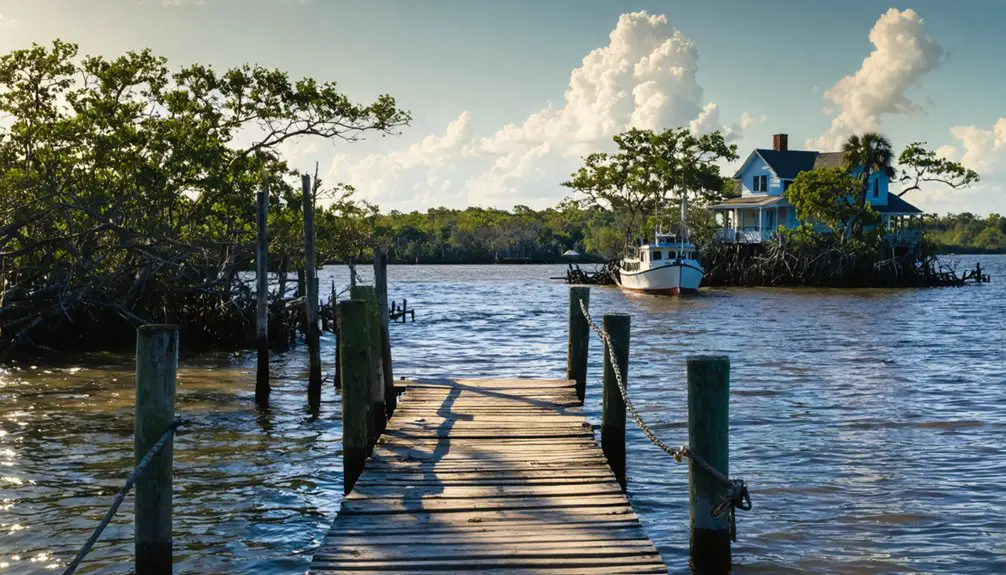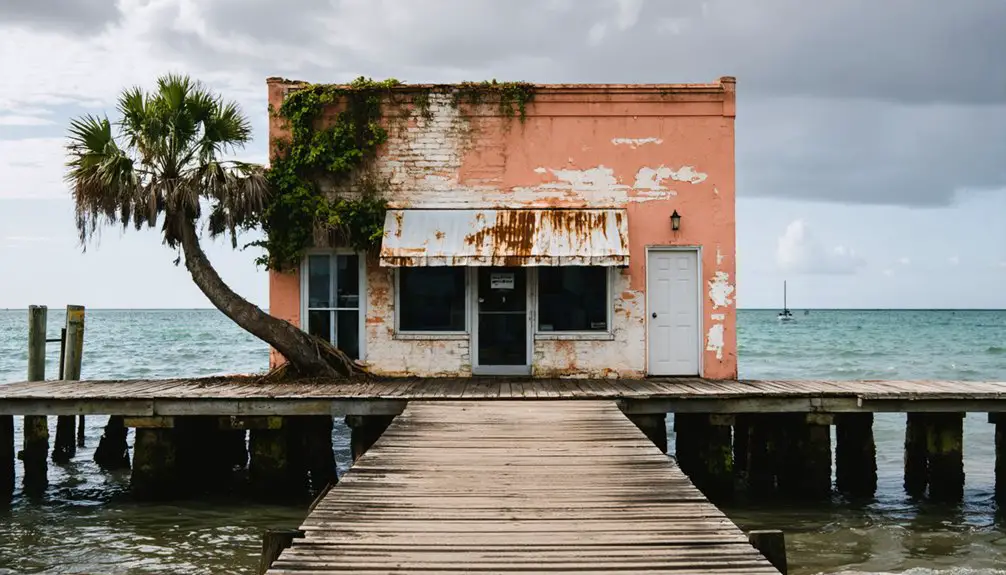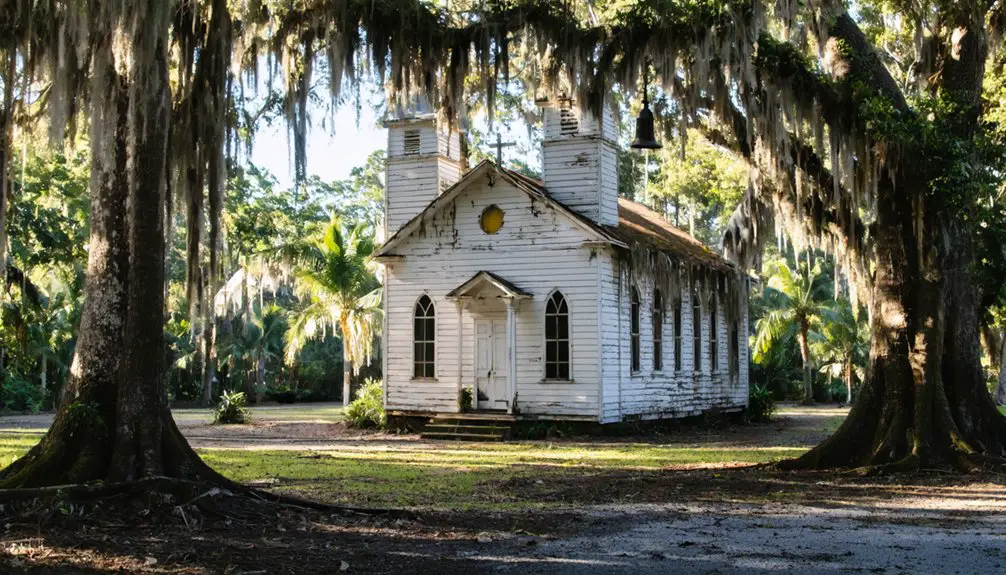You’ll find the once-bustling port town of Palma Sola nestled along Manatee County’s waterfront, where James Warner established a settlement in 1868. Named for its solitary palm that guided sailors, this “dry” community grew into a major commercial hub with the region’s largest general store between Cedar Keys and Key West. While no longer the busy port it once was, Palma Sola’s historic district still showcases its rich pioneer heritage through preserved “Old Florida” architecture and enduring local legends.
Key Takeaways
- Palma Sola thrived as a commercial hub in the 1880s but gradually declined after Bradenton’s growth in the early 20th century.
- The settlement’s historic district preserves “Old Florida” architecture from the 1920s and 1930s, maintaining inhabited structures from its peak period.
- Once Florida’s largest general store between Cedar Keys and Key West operated in Palma Sola before the area’s commercial decline.
- The Palma Sola Hotel, a major transportation hub in the 1880s, marked the settlement’s golden era before port activities diminished.
- Despite its “ghost town” status, Palma Sola maintains inhabited residences and preserved buildings while carrying historic significance in Florida’s development.
The Solitary Palm That Named a Town
Navigation was simpler in the days when a single majestic palm tree stood proudly on Snead Island, serving as a natural beacon for sailors crossing Palma Sola Bay.
You could spot this solitary sentinel from miles away, its distinctive silhouette guiding vessels safely through the waters of the Manatee River to harbor.
The palm’s symbolism ran deep in the local maritime culture, so much so that settlers named their community “Palma Sola,” meaning “solitary palm” in Spanish.
James Warner first established the settlement in 1868, laying the foundation for what would become a thriving waterfront community.
This natural landmark became woven into the area’s identity, inspiring everything from the local country club’s logo to the naming of streets and neighborhoods.
Today, the 10-acre park continues this botanical legacy, with its protected warm microclimate nurturing an extraordinary collection of rare palms and subtropical plants.
Even today, you’ll find this palm’s legacy preserved in the frost-free botanical gardens that celebrate the region’s unique connection to these remarkable trees.
Warner Family’s Pioneer Settlement
When James Warner, a prominent firearms manufacturer from Springfield, Massachusetts, relocated to Manatee County in 1868, he couldn’t have known that his family would become instrumental in founding one of the area’s most significant settlements.
Though James died just a year after arrival, his wife Eleanor and their children carried forward his pioneer spirit. Today, visitors can explore this rich history through digital collections that preserve the Warner family’s legacy. The Warner legacy took root along the Manatee River near Palma Sola Point, where they established a homestead that would remain in their family for over a century. Their lasting impact can still be seen today in the name Warners Bayou given to the area.
Despite the early loss of James Warner, his family’s perseverance established a lasting pioneer legacy along Florida’s Manatee River.
Through pioneer struggles and determination, James’s son Warburton S. Warner founded the town of Palma Sola in 1884, establishing it as a New England-influenced “dry” community.
The family’s sawmill became the heart of the settlement, providing lumber for the town’s growth and supporting broader commercial development through their waterfront operations.
Rise as Manatee County’s Commercial Hub
Building upon the Warner family’s pioneering foundation, Palma Sola rapidly emerged as Manatee County’s bustling commercial center in the late 1880s.
You’d find the region’s largest general store between Cedar Keys and Key West, alongside an impressive commercial infrastructure that included a lengthy wharf, warehouses, and an ice house large enough to supply entire schooners.
The town’s strategic position on the Manatee River, marked by its iconic tall date palm, made it a crucial link in Florida’s trade routes. Ships could efficiently load and unload at the docks, connecting inland agricultural producers with coastal markets. The area’s abundant shell mounds left by native Calusa tribes provided valuable construction materials for early development.
The two-story Palma Sola Hotel welcomed travelers, while the sawmill provided steady employment. New England settlers, committed to temperance principles, established a unique commercial culture that would influence the region’s development for decades. The area’s significance continued into the 1920s when Donald Ross designed the local golf course.
Industrial Glory Days: Timber and Trade
Throughout the late 1880s, Palma Sola‘s industrial might centered around its bustling sawmill operations and strategic trade position along the Manatee River. The town’s timber heritage flourished with steam-powered mills churning out up to 450,000 board feet annually, while its impressive wharf facilitated regional commerce. Early pioneers like J.A. Felts helped establish the town’s industrial foundations through their entrepreneurial ventures. As was common in the era, workers faced harsh working conditions with long hours, low wages, and high injury risks.
You’ll find Palma Sola’s trade evolution marked by these pioneering developments:
- The largest warehouse and general store between Cedar Keys and Key West
- Ice houses storing schooner-loads of New England pond ice
- The landmark Palma Sola Hotel serving merchants and travelers
- A wooden bridge to Perico Island built in 1921
This industrial prowess established Palma Sola as Manatee County’s commercial powerhouse, with timber operations supporting local families through ownership and seasonal labor opportunities, until larger cities eventually overshadowed its prominence.
Life in Early Palma Sola Society
If you’d lived in early Palma Sola, you would’ve found yourself in a tight-knit New England-influenced community where the Palma Sola Hotel and Community Church served as social anchors.
Your daily routine would’ve revolved around the rhythms of sawmill work, fishing, or farming, with leisure time spent at community gatherings and river recreation.
You’d have adhered to the town’s strict prohibition on liquor sales, reflecting the Victorian values that shaped this family-oriented settlement’s social fabric. The town was established by Warburton Warner, who envisioned creating a wholesome community for families.
Daily Pioneer Life
Life in early Palma Sola centered around a bustling mix of industrial and maritime activities, with residents dividing their time between the McNeill Point sawmill, fishing boats, and agricultural pursuits.
You’d find the town’s spirit reflected in its diverse daily activities:
- Starting your day at dawn, you’d join fellow workers at the sawmill or head to the wharf to prepare fishing vessels.
- After work, you’d gather with neighbors at the general store, the largest between Cedar Keys and Key West.
- You’d attend community gatherings at the Palma Sola Community Church, built by pioneer Asa Pillsbury.
- In the evening, you might socialize at the Palma Sola Hotel, where Warner’s no-liquor policy kept gatherings wholesome.
The town’s population of 962 lived a life that balanced hard work with strong community bonds.
Social Rules and Customs
Early Palma Sola’s social fabric wove together a tapestry of unwritten rules and cherished customs that shaped daily interactions.
You’d find social interactions unfolding on hotel porches, where locals and wealthy northern visitors mingled while smoking pipes and sharing stories. Community traditions centered around outdoor activities – fishing expeditions, alligator hunts, and riverside picnics brought everyone together regardless of social standing.
Though class distinctions existed between pioneer families and Gilded Age tourists, you’d notice how natural surroundings leveled the social playing field. The area initially thrived around a lumber mill and store that served as key gathering places for residents.
Conservative values guided behavior, with the general store’s no-liquor policy reflecting wider moral expectations. Women attended finishing schools while men worked the lumber mills, and you’d see these gender roles play out in daily life, though frontier conditions often demanded flexibility in traditional roles.
The Historic Palma Sola Hotel Era
If you’d visited Palma Sola Hotel in the 1880s, you’d have found yourself in a two-story riverfront establishment on McNeill Point, where scenic views and luxurious accommodations awaited weary travelers.
You could’ve arrived by train from Jacksonville or by boat from Tampa Bay, making the hotel a crucial transportation hub in Manatee County’s early tourism industry.
The hotel’s prominent location, complete with a long wharf and ice house, made it the perfect base for visitors exploring the region’s timber, fishing, and agricultural attractions.
Luxury Riverfront Accommodations
Built around 1880 by town founder Warburton S. Warner, the Palma Sola Hotel stood as one of Florida’s premier riverfront retreats.
You’d find this two-story wooden masterpiece perched on McNeill Point, where luxury amenities met the natural beauty of the Manatee River.
The hotel’s sophisticated offerings included:
- A sprawling, breezy front porch where you’d catch invigorating river breezes while taking in spectacular views
- Multiple guest rooms with premium riverfront vistas, designed for your ultimate comfort
- Access to a lengthy wharf where steamships from Tampa Bay would dock
- An ice house capable of handling schooner-sized shipments, ensuring your drinks stayed cool
Whether arriving by train from Jacksonville or boat from Tampa Bay, you’d discover a tropical paradise where northern tourists escaped their busy city lives.
Tourist Transportation Hub
During the late 1800s, the Palma Sola Hotel transformed McNeill Point into a bustling transportation hub where northern travelers converged by train and steamship. You’d find yourself arriving either by rail from Jacksonville or aboard vessels crossing Tampa Bay, stepping onto a lengthy wharf purpose-built for tourist influx.
Transportation developments quickly expanded your travel options. The 1921 wooden bridge to Perico Island opened new pathways, while footbridges across bayous connected you to Bradentown and Manatee.
The town’s strategic location gave you easy access to the Manatee River‘s attractions and Desoto National Memorial Park. The general store, one of the largest between Cedar Keys and Key West, guaranteed you’d have everything needed for your stay in this flourishing tourist destination.
From Bustling Port to Quiet Neighborhood

When Palma Sola first emerged in 1868, it held the distinction of being Manatee County’s largest city, thriving as an essential port that connected Tampa Bay’s shipping routes to inland waterways.
The maritime navigation hub underwent a dramatic residential change as Bradenton’s growth overshadowed it in the early 20th century.
You’ll discover how this once-bustling port transformed into a peaceful neighborhood through these key changes:
- The 1920s land boom shifted development toward Palma Sola Park, featuring grand Spanish-style mansions.
- Commercial port activities gradually diminished as Bradenton became the region’s dominant city.
- The area’s focus turned to creating maintained parks and residential spaces.
- Modern zoning preserved the quiet character while maintaining water access through the yacht club.
Notable Residents and Local Legends
The rich tapestry of Palma Sola’s history comes alive through its remarkable residents and enduring local legends.
You’ll find the fingerprints of baseball icon Dizzy Dean, who owned a local gas station and kept a goat to trim his lawn in the 1930s. His presence, along with the “Gas House Gang,” cemented the town’s connection to America’s favorite pastime.
Beyond sports figures, you’ll discover haunting ghost stories, including the controversial 1927 tale of an Indian raid on the local school. While the kidnapping story’s accuracy remains doubtful, it’s woven into the town’s folklore.
Tales of a disputed 1927 Indian school raid echo through local lore, a ghostly reminder of Palma Sola’s mysterious past.
Early pioneers like Warburton S. Warner and Asa Pillsbury shaped the community’s character, with Pillsbury establishing the local church.
Even Thomas Edison’s secretary left a mark, building one of the original homes in the 1920s planned community.
Architectural Heritage and Landmarks

Magnificent examples of “Old Florida” architecture grace Palma Sola’s historic district, where 1920s and 1930s homes showcase the region’s distinctive character.
You’ll find a blend of craftsman, bungalow, and Mediterranean Revival influences throughout these preserved structures, many smartly updated while maintaining their historical facades.
The area’s architectural significance is best experienced through:
- The historic Palma Sola Community Church, with its simple wood-frame construction representing early settler life
- Stately waterfront mansions along Palma Sola Boulevard featuring mid-century modern design
- Converted properties like the 1920s finishing school, now a unique residence retaining its dormitory elements
- Bridge remnants from 1921 that tell the story of the area’s transformation from isolated settlement to connected community
Historic preservation efforts have protected these landmarks, ensuring Palma Sola’s architectural heritage endures for future generations.
Modern Traces of a Pioneer Past
Modern explorers of Palma Sola’s quiet streets can still discover tangible links to its pioneer roots, from the historic tall date palm on Snead Island that gave the town its name to Warner’s Bayou where the first settlers made their home in 1868.
You’ll find cultural continuity in the active cemetery with its 19th-century gravestones, and the preserved Palma Sola Community Church, built with timbers salvaged from Tampa Bay shipwrecks.
The winding streets of Palma Sola Park showcase palm trees descended from Thomas Edison’s estate, while pioneer preservation efforts keep the area’s unique heritage alive.
Warner’s original settlement point near the river, though transformed, still anchors the community’s geography.
The town’s distinctive New England character endures through local folklore, architectural remnants, and the descendants of Cortez families who’ve worshipped here for generations.
Frequently Asked Questions
What Was the Average Property Value in Palma Sola During the 1880S?
From dirt-cheap farmland to coveted waterfront plots, you’d find property value fluctuations ranging $1-20 per acre, influenced by economic factors like location and water access in 1880s Palma Sola.
Were There Any Significant Natural Disasters That Affected Early Palma Sola?
You’ll find that hurricane impacts regularly threatened Palma Sola’s coastal infrastructure, while devastating fires in the 1890s destroyed key buildings. Flooding events, particularly from the 1921 hurricane, battered the region.
How Did Residents Get Their Drinking Water in Early Palma Sola?
You’d have collected your drinking water through hand-dug wells near your home, while supplementing with rain catchment systems using barrels and cisterns to store precious freshwater during drier times.
What Native American Tribes Lived in the Area Before Settlement?
Like footprints in time’s sand, you’d have found Native tribes of the Calusa and Timucua in this region, leaving behind their rich cultural heritage through shell middens and ancient settlements.
Did Palma Sola Have Its Own Newspaper During Its Peak Years?
You won’t find evidence of a dedicated newspaper in Palma Sola’s local journalism history. The town relied on regional papers and William Drysdale’s articles published elsewhere to spread its news.
References
- https://www.sarasotamagazine.com/home-and-real-estate/2017/06/hometown-bradenton
- https://www.ghosttowns.com/states/fl/palmasola.html
- https://www.hmdb.org/m.asp?m=72427
- https://cdm16681.contentdm.oclc.org/digital/custom/palma_sola
- https://en.wikipedia-on-ipfs.org/wiki/Palma_Sola
- https://palmasolabp.org/about/
- https://www.palmasolaparkassociation.com/about-the-park
- https://www.bradentoncc.org/history
- https://www.manateevillage.org/post/william-drysdale-palma-sola
- https://www.hmdb.org/m.asp?m=102973



